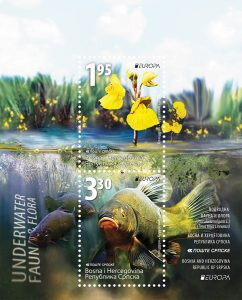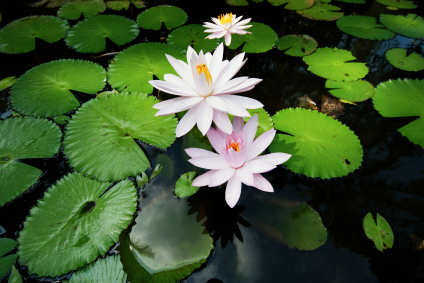Souvenir Sheet: Europa (C.E.P.T.) 2024 - Underwater Flora and Fauna (Bosnia and Herzegovina, Serbian Admin 2024)
Europa (C.E.P.T.) 2024 - Underwater Flora and Fauna (Bosnia and Herzegovina, Serbian Admin 2024)
17 June (Bosnia and Herzegovina, Serbian Admin ) within release Europa (C.E.P.T.) 2024 - Underwater Flora and Fauna goes into circulation Souvenir Sheet Europa (C.E.P.T.) 2024 - Underwater Flora and Fauna face value 5.20 Bosnia and Herzegovina convertible mark
| Souvenir Sheet Europa (C.E.P.T.) 2024 - Underwater Flora and Fauna in catalogues | |
|---|---|
| Colnect codes: | Col: BA-SR 2024.06.17-03 |
Souvenir Sheet is square format.
Also in the issue Europa (C.E.P.T.) 2024 - Underwater Flora and Fauna:
- Stamp - Europa (C.E.P.T.) 2024 - Underwater Flora and Fauna face value 1.95;
- Full Pane - Europa (C.E.P.T.) 2024 - Underwater Flora and Fauna face value 8*1.95;
- Full Pane - Europa (C.E.P.T.) 2024 - Underwater Flora and Fauna face value 8*3.30;
- Stamp - Europa (C.E.P.T.) 2024 - Underwater Flora and Fauna face value 3.30;
- Souvenir Sheet - Europa (C.E.P.T.) 2024 - Underwater Flora and Fauna face value 5.20;
Souvenir Sheet Europa (C.E.P.T.) 2024 - Underwater Flora and Fauna it reflects the thematic directions:
Aquatic plants are plants that have adapted to living in aquatic environments (saltwater or freshwater). They are also referred to as hydrophytes or macrophytes. These plants require special adaptations for living submerged in water, or at the water's surface. The most common adaptation is aerenchyma, but floating leaves and finely dissected leaves are also common.
The principal factor controlling the distribution of aquatic plants is the depth and duration of flooding. However, other factors may also control their distribution, abundance, and growth form, including nutrients, disturbance from waves, grazing, and salinity.
Aquatic vascular plants have originated on multiple occasions in different plant families; they can be ferns or angiosperms (including both monocots and dicots). Seaweeds are not vascular plants; rather they are multicellular marine algae, and therefore are not typically included among aquatic plants. A few aquatic plants are able to survive in brackish, saline, and salt water. Examples are found in genera such as Thalassia and Zostera. Although most aquatic plants can reproduce by flowering and setting seed, many also have extensive asexual reproduction by means of rhizomes, turions, and fragments in general.
One of the largest aquatic plants in the world is the Amazon water lily; one of the smallest is the minute duckweed. Many small aquatic animals use plants like duckweed for a home, or for protection from predators, but areas with more vegetation are likely to have more predators. Some other familiar examples of aquatic plants might include floating heart, water lily, lotus, and water hyacinth.
Some aquatic plants are used by humans as a food source. Examples include wild rice (Zizania), water caltrop (Trapa natans), Chinese water chestnut (Eleocharis dulcis), Indian lotus (Nelumbo nucifera), water spinach (Ipomoea aquatica), and watercress (Rorippa nasturtium-aquaticum).
A fish is any member of a group of animals that consist of all gill-bearing aquatic craniate animals that lack limbs with digits. They form a sister group to the tunicates, together forming the olfactores. Included in this definition are the living hagfish, lampreys, and cartilaginous and bony fish as well as various extinct related groups. Tetrapods emerged within lobe-finned fishes, so cladistically they are fish as well. However, traditionally fish are rendered obsolete or paraphyletic by excluding the tetrapods (i.e., the amphibians, reptiles, birds and mammals which all descended from within the same ancestry). Because in this manner the term "fish" is defined negatively as a paraphyletic group, it is not considered a formal taxonomic grouping in systematic biology. The traditional term pisces (also ichthyes) is considered a typological, but not a phylogenetic classification. The earliest organisms that can be classified as fish were soft-bodied chordates that first appeared during the Cambrian period. Although they lacked a true spine, they possessed notochords which allowed them to be more agile than their invertebrate counterparts. Fish would continue to evolve through the Paleozoic era, diversifying into a wide variety of forms. Many fish of the Paleozoic developed external armor that protected them from predators. The first fish with jaws appeared in the Silurian period, after which many (such as sharks) became formidable marine predators rather than just the prey of arthropods. Most fish are ectothermic ("cold-blooded"), allowing their body temperatures to vary as ambient temperatures change, though some of the large active swimmers like white shark and tuna can hold a higher core temperature. Fish are abundant in most bodies of water. They can be found in nearly all aquatic environments, from high mountain streams (e.g., char and gudgeon) to the abyssal and even hadal depths of the deepest oceans (e.g., gulpers and anglerfish). With 33,100 described species, fish exhibit greater species diversity than any other group of vertebrates. Fish are an important resource for humans worldwide, especially as food. Commercial and subsistence fishers hunt fish in wild fisheries (see fishing) or farm them in ponds or in cages in the ocean (see aquaculture). They are also caught by recreational fishers, kept as pets, raised by fishkeepers, and exhibited in public aquaria. Fish have had a role in culture through the ages, serving as deities, religious symbols, and as the subjects of art, books and movies.


